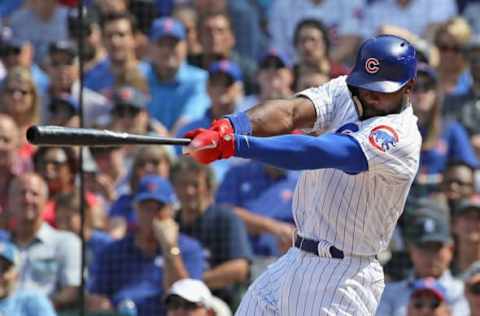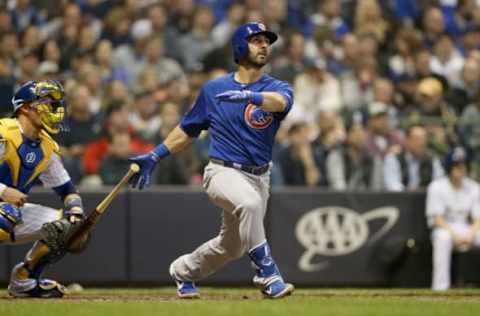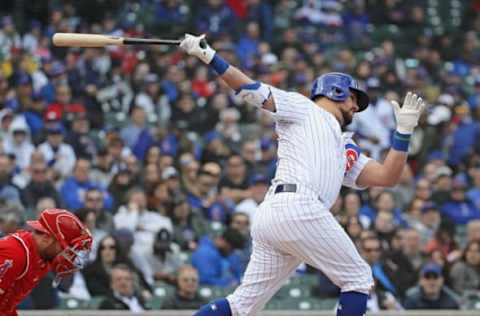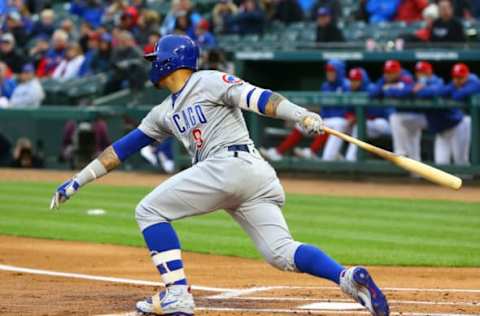Chicago Cubs: The first-pitch and 2-2 batting struggles


The Chicago Cubs bats keep getting better and better. But if there is any weakness in the team’s hitting, it’s on the first pitch and the 2-2. Why does this cause so many problems?
There are some mysteries in life my Chicago Cubs friends that are never meant to be answered. They are mysteries wrapped inside a riddle wrapped inside an enigma. Like the Bermuda Triangle or where Jimmy Hoffa is buried, we will never know some things in life. So it is as well with the mysterious first-pitch in baseball.
Should he swing? Should he sit? What should the batter do? What is correct?
This is exactly what the Chicago Cubs have been facing lately, and the first-pitch has gotten many of the Cubs this season. Many grey beards like to pontificate on this very subject and can spend an entire day in both the barbershop and in online sports rooms chatting away about this very subject.
The other dear in the headlight pitch for the Cubs is the 2-2. More Cubs are leaving on the 2-2 than the 3-2 these days! Perhaps a little better understanding of these pitches and what the batter and pitcher are trying to accomplish will shed some needed light on the subject.

Chicago Cubs: The First Pitch
So we know this pitch is the most debated in baseball but what are the batter’s view and the pitcher’s view of this pitch? Understanding what each is trying to make happen could be the key to swinging or sitting.
The batter is, of course, pumped up and wants to hit and so back in the 80’s a new term became popular in baseball to explain this enthusiasm, called “ambush hitting.” This is when the hitter shows no fear and swings hard like he’s going for a dinger on the very first-pitch thrown. So one of the rules of the first-pitch is:
if you’re going to swing, swing hard.
Now we’re only talking about the swing and not the ball. Los Angeles Angels hitter Mike Trout gets so many hits because he waits for the ball to be in his hitting zone, you could also say the same for Los Angeles Dodger Cody Bellinger and even Chicago Cub second baseman Daniel Descalso. The ball cannot be high, low, in or out of the zone. If the batter is considering swinging, the ball can only be in a perfect position or leave it. So another rule of the first-pitch is:
It must be in the zone if you’re going to swing.
Another huge consideration is the log of the game. How many outs are there? What inning are we in? How many pitches has the pitcher thrown? What’s the score? Are there batters on base? What hitter am I in the lineup? What has he been throwing on first-pitches and how effective have they been? A batter with this type of knowledge has an advantage in determining how enthusiastically he wants to approach the first-pitch. A pitcher who is at the end of his string with a fastball that has steadily declined throughout the game may not have the power to deliver a well-placed hitting strike. However, if that pitcher consistently tried to throw the fastball on the first-pitch, you may be in for a treat! Again, it should be in your zone and swing hard!

Chicago Cubs: Sitting on the first-pitch
Many folks teach and tout to ‘Never swing at the first-pitch’ like religion.
Why?
These Merlin’s of Mathematical Computation have figured that if you swing the bat on the first pitch, there can only be these results:
1. You get a base hit or more
2. You get a strike
3. You get a foul ball (strike)
Since two out of three of these is a negative against the batter, the computation means it is not in a hitter’s best interest to swing at the first-pitch. If you are still not convinced, you can also take this into consideration.
1. You get a base hit or more (but the pitcher has only wasted one pitch on his arm)
2. You get a strike (but the pitcher has just spent one pitch on his arm)
3. You get a foul ball (strike) (but the pitcher has only wasted one pitch on his arm)
More from Chicago Cubs News
- Cubs starting pitching has been thriving on the North Side
- Make no mistake: the Cubs are very much about power hitters
- Cubs: It’s time to start thinking about potential September call-ups
- Cubs: P.J. Higgins deserves to be in the lineup on a daily basis
- Cubs might start to limit Justin Steele’s workload soon
As you can see, every outcome carries a negative because you’re not running up the count and the pitcher is still brand new (basically) when he faces your second batter. There is a high probability the first-pitch hitter will get stranded on base.
It seems the answer is, not to swing at the first-pitch like the Cubs shortstop Javier Baez does quite often and let the count develop and put some wear and tear on the pitcher’s arm. However, you should always watch for your perfect pitch and if the pitcher delivers it, crush it. If your team is down and it’s the ninth inning, then you might be considering that first-pitch and expanding the zone.
The Chicago Cubs have been hitting on and off. For the most part, many of the Chicago Cubs will not swing at the first pitch thrown. What they need to be careful of is the other team’s scouting report! These pitchers know Chicago Cubs outfielder Kyle Schwarber is going to sit on the first-pitch and so they do their best to get him behind with a strike right away.
If the Chicago Cubs can take better advantage of the first pitch, they will control the bases more effectively. However, even after the first-pitch, the 2-2 has got the Cubs running.

Chicago Cubs: The 2-2 pitch
I’m seeing many Cubs go down on the 2-2 pitch thinking they must swing. Most often they hit into a double-play or an infield ground out. Again, the log of the game should help determine whether a batter can swing or not but more hitters need to consider sitting on the 2-2 instead of swinging.
Most pitchers who are in a 2-2 situation want the batter to swing but don’t want to give him a strike to swing at. They will put a lot of seasoning on the ball to make it look good, but most 2-2 pitches will end up as balls. Occasionally, a pitcher will put heat on the 2-2 to get out of an inning or to rush the batter. Most of the time, these end up as balls as well, and if they do get in the zone, it’s not by much.
Sometimes I think the Cubs worry too much about the leadoff hitter as opposed to the first-pitch. While for the most part, the Cub’s production has looked good this year, we still see these gaps without a score which is very reminiscent of last season.
Next. More to Darvish than his pitching. dark
While the first-pitch approach is destined to remain one of baseball’s mysteries, maybe a bit of ambush hitting can get the blood pumping back in the Cubs lineup and a little patience on the 2-2 might provide some more base runners.
There’s no mystery that we need it.